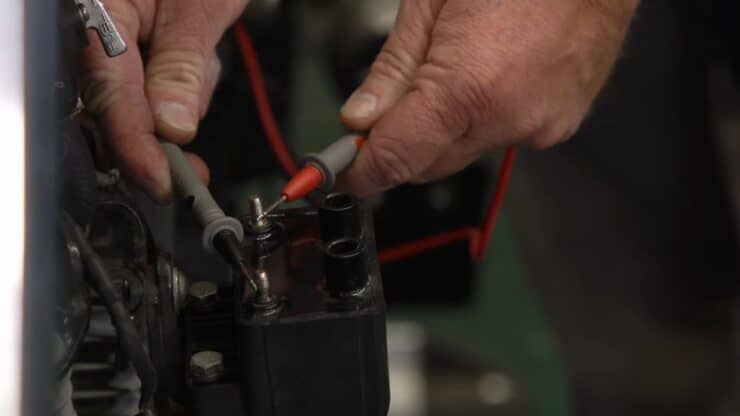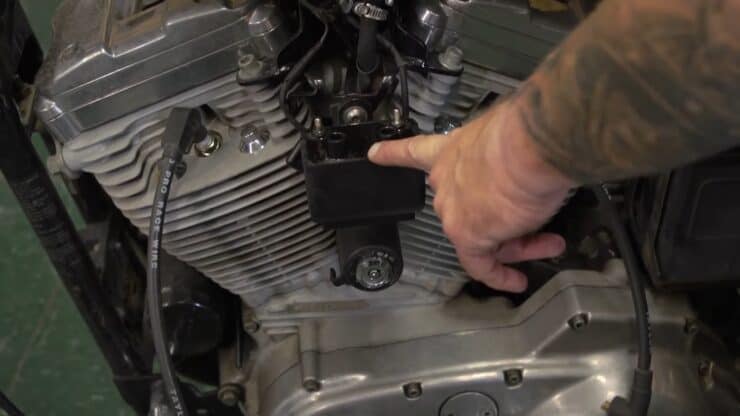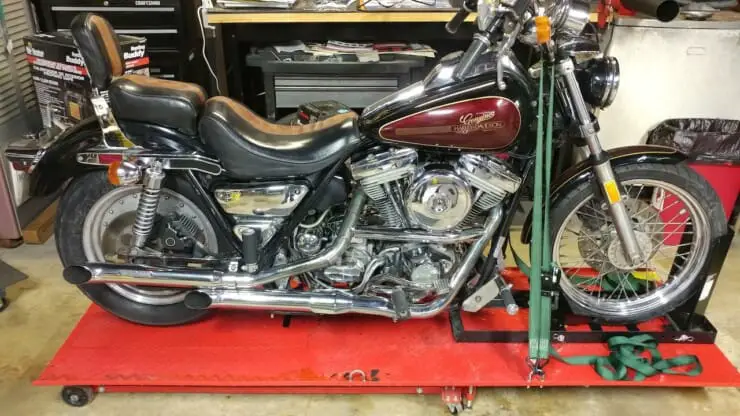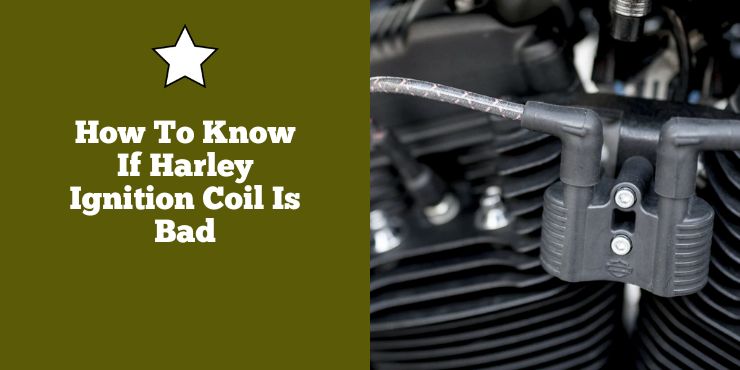Are you having trouble starting your Harley? If so, it’s likely due to a faulty ignition coil.
A failing Harley ignition coil often causes misfires, difficulty starting, poor fuel economy, and weak spark. Testing with a multimeter can confirm if the resistance is out of spec, indicating a need for replacement.
In this article, we’ll explain how to diagnose the problem and what you can do to fix it. Read on to learn more and get your Harley back in top condition!
Overview of Harley-Davidson ignition coil
There are numerous reasons why your Harley-Davidson bike might not start. The battery may be reaching its end or could be completely flat, the carburetors may be clogged, or your bike might be running on bad fuel. There might even be issues with the internals, such as off timing or the bike’s engine failing to tick over. Lastly, you can also blame poor maintenance or lack of proper lubrication.
But have you considered that it may be due to problems with the ignition coil? After all, the starters could fail, electric wires may corrode, spark plugs may get dirty, or the ignition coil might be acting up. These issues are more common issues than you may think, but they can be resolved quickly and cheaply.
Definition of Harley-Davidson ignition coil
One of the critical components of any Harley-Davidson bike is the ignition coil, which converts the low voltage from the battery into the high voltage required for igniting the fuel mixture in the combustion chamber.
In an internal combustion engine, the ignition coil will generate the high voltage needed for creating a spark in the spark plug. This spark will ignite the fuel-air mixture, which then drives the engine. Harley-Davidson ignition coils are designed for providing the necessary high voltage for the spark plug in a reliable and consistent manner.
Harley-Davidson ignition coils are made using high-quality materials and designed to be able to withstand the rigors of motorcycle operations. The coils are typically located near the spark plug and are connected to the Harley-Davidson bike’s electrical system through the wires. Harley-Davidson ignition coils come in various types, including single-fire and dual-fire.
Single-Fire ignition coils – Single-fire ignition coils are designed for firing a single spark plug at a time. This kind of ignition coil is used in Harley-Davidson bikes that have a single spark plug per cylinder. This single-fire ignition coil is triggered by the bike’s Electronic Control Module (ECM) and delivers a high-voltage spark to the spark plug, igniting the fuel-air mixture in the combustion chamber.
Dual-Fire ignition coils – Dual-fire ignition coils are designed for firing two spark plugs simultaneously. This type of ignition coil is used in Harley-Davidson bikes that have two spark plugs per cylinder. The dual-fire ignition is triggered by the bike’s ECM and delivers a high-voltage spark to both plugs, igniting the fuel-air mixture in the combustion chamber.

Importance of Harley-Davidson ignition coils
The ignition coil is a key component of any Harley-Davidson bike’s ignition system. Without properly functioning ignition coils, the motorcycle won’t start or run correctly. Harley-Davidson ignition coils are designed for providing reliable and consistent performance, ensuring that the bike runs smoothly and efficiently.
In addition to their importance in the operation of the bike, Harley-Davidson ignition coils are also critical for safety. A faulty ignition coil could cause the motorcycle to stall or misfire, which can be dangerous, especially at high speeds. Regular maintenance and replacement of faulty ignition coils can help in preventing accidents and ensures that the bike is always operating at its best.
How do ignition coils work?
Ignition coils are a part of the Harley-Davidson bike’s ignition system. The job of ignition coils is to increase the voltage coming from the bike’s battery. 12V will not be enough to get you anywhere, so the coils can increase the battery’s input voltage to around, 30000V.
Essentially, a Harley-Davidson ignition coil is a step-up transformer. It consists of two separate wire coils known as “primary” and “secondary” coils, each one wound around a central iron core. The primary ignition coil has various windings of a thicker wire, while the secondary ignition coil has thousands of windings in thinner gauge wires. When the spark is required, the 12V from the battery gets cut off. As a result, it’ll cause a drop in the magnetic field in the primary coil but induce a significantly higher voltage in the secondary coil needed to work the plugs.
As with anything else, timing will be important here. The right amount of voltage at the right time will be controlled by the onboard computer that receives the input from a series of sensors. The sensors will respond to changes in the magnetic fields of the coils. The computers sync the work of the injectors so that the right amount of fuel gets ignited at the right time at the correct temperatures.
How to know if Harley ignition coil is bad
Harley-Davidson bikes are known best for their power and performance. However, like any other bike, even they’ll require proper maintenance for functioning optimally. As mentioned before, one of the critical components of a Harley’s ignition system is the ignition coil. A faulty ignition coil can cause various problems such as decreased performance, difficulty starting, and more. Here are the symptoms for how to know if Harley ignition coil is bad –
#1. Decreased performance
A bad ignition coil will cause decreased engine performance, resulting in reduced power and sluggish acceleration. This occurs because the ignition coil is responsible for delivering the high voltage needed for igniting the fuel-air mixture in the combustion chamber. A weak spark caused by a faulty ignition coil could result in incomplete combustion, leading to decrease engine performance.
#2. Poor fuel economy
Another reason why your Harley has a bad ignition coil will be due to poor fuel economy. This is because the engine’s fuel efficiency will depend on the complete combustion of the fuel-air mixture in the combustion chamber. If the spark delivered by the ignition coil is weak, it could result in incomplete combustion, leading to lower fuel efficiency.
#3. Difficulty starting
Another symptom that you have a bad ignition coil is difficulty in starting the engine. This occurs because the ignition coil is responsible for delivering the high voltage needed for igniting the fuel-air mixture in the combustion chamber. If the ignition coil is weak or faulty, it might not deliver the required voltage for starting the engine, which can result in difficulty starting your Harley.
#4. Engine misfires
An engine misfire typically occurs when the fuel-air mixture in the combustion chamber fails to ignite or ignites poorly. This can easily result in a rough idle, increased emissions, and reduced power. A bad ignition coil could cause engine misfires, as it can deliver a weak spark, which results in incomplete combustion of the fuel-air mixture in the combustion chamber.
#5. Illuminated check engine light
A bad ignition coil could cause the check engine light to illuminate on the dashboard. The check engine light could indicate a wide variety of issues, including a faulty ignition coil. If the check engine light is illuminated, it’ll be best to have a professional mechanic diagnose and repair this issue.
How to diagnose a bad ignition coil
Harley-Davidson bikes are known for their power and performance, but like any other bike, they also need regular maintenance for running smoothly. If you have a bad ignition coil, you can easily resolve the issues by finding out the faults and diagnosing them accordingly. Here are the different ways through which you can diagnose a bad Harley ignition coil –
#1. Check the spark plugs
One of the first things that you should consider when diagnosing a bad ignition coil will be the spark plugs. The spark plugs are responsible for igniting the fuel-air mixture in the combustion chamber. If the spark plugs are faulty, they could result in various issues such as difficulty starting and engine misfires. For checking the spark plugs, you should remove them from the engine and inspect them for potential wear or damage. If the spark plugs are worn, fouled, or damaged, they will have to be replaced. If the spark plugs are in decent working condition, you should proceed to the next step.
#2. Measuring voltage
Measuring the voltage delivered by the ignition coil will be another way of diagnosing a bad ignition coil. To measure the voltage, you will require a quality digital multimeter. Then, set it to the voltage setting and then connect the positive lead to the positive terminal of the ignition coil. Meanwhile, connect the negative lead to the negative terminal. With the ignition on, you will have to measure the voltage. A healthy ignition coil should be good enough to deliver a voltage of around 12 to 14 volts. If the voltage is lower than this, then your ignition coil might be faulty.
#3. Checking resistance
Checking the resistance of the ignition coil will be another way of diagnosing a bad Harley ignition coil. For checking the resistance, you will have to use a digital multimeter. Then, set the multimeter to the resistance setting before connecting the positive lead to the positive terminal of the ignition coil and the negative lead to the negative terminal. The resistance of a high-quality ignition coil will ideally be between 0.5 to 5 ohms. If the resistance is higher than that, the ignition coil might be faulty.
#4. Check the battery
One of the ways you can diagnose a bad Harley ignition coil would be to check the battery voltage of the bike. A weak battery could result in several issues, such as a lack of power to the ignition coil. For checking the battery voltage, you should make use of a digital multimeter and then set it to the DC voltage setting. Connect the positive lead to the positive terminal of the battery and the negative lead to the negative terminal. The voltage reading will have to be between 12 and 14 volts. If the voltage is lower than that, then the battery might be weak, and it’ll have to be charged or replaced.
#5. Check for spark
Checking for spark will be another great way of diagnosing a bad ignition coil. For doing this, you should remove the spark plug from the engine and then attach it to the ignition coil wire. Ground the spark plug to the engine before cranking the engine. If there is a spark, it means that the ignition coil is working correctly. Whereas, if there is no spark, then it is a sign that the ignition coil might be faulty.

How to replace the ignition coil?
If you have diagnosed a bad Harley ignition coil in your Harley-Davidson motorcycle, and it is still not working, then the only possible way to fix the situation would be to replace the faulty coil with a new one. Here are the step-by-step instructions on how to replace the faulty ignition coil in your Harley-Davidson bike –
Step 1: Purchase a new coil
When you’re purchasing a new coil, it will be important that you ensure that it is compatible with your Harley-Davidson bike’s model and year. You can easily consult the owner’s manual or contact the manufacturer to confirm compatibility. You might also want to consider purchasing a high-performance ignition coil for improved performance.
Step 2: Installing the new coil
For installing the new ignition coil, you will need to follow these steps –
- Disconnect the battery – Before you start the installation, it’ll be essential to disconnect the battery for preventing any electrical shocks
- Locate the old ignition coil – The ignition coil is generally located near the engine or under the fuel tank
- Remove the old ignition coil – Make use of a socket wrench for removing the bolts securing the ignition coil to the bike’s frame and disconnect the wires from the old ignition coil
- Install the new ignition coil – Attach the new ignition coil to the bike’s frame using the bolts removed earlier and then connect the wires to the new ignition coil
- Reconnect the battery – Once the new ignition coil has been installed, you’ll need to reconnect the battery
Step 3: Testing the ignition coil
After installing the new ignition coil, it will be important to test it to ensure it is working properly. Here is how to test the new ignition coil –
- Turn on the ignition – Turn on the ignition and check for any warning lights or check the engine lights. If there aren’t any warning lights, you should proceed to the next step.
- Start the engine – Now, start the engine and listen for any vibrations or unusual noises. If the engine starts and runs smoothly, you should proceed to the next step.
- Check for spark – Remove one of the spark plugs and then attach it to the ignition coil wire. Ground the spark plug to the engine before cranking the engine. If there is a spark, the new ignition coil will work correctly. If there is no spark, you should double-check the installation and wiring connections.
- Measure the voltage – Use a digital multimeter for measuring the voltage delivered by the new ignition coil. Connect the positive lead to the positive terminal of the ignition coil. Meanwhile, the negative lead should be connected to the negative terminal. With the ignition on, you should measure the voltage. A healthy ignition coil will deliver a voltage of approx. 10 to 14 volts.

How to prevent ignition coil issues
Harley-Davidson bikes are known best for their unique designs, powerful engines, comfort levels, and the novelty that comes with driving a Harley. However, one of the common issues that may arise in Harley-Davidson is a faulty ignition coil. Ignition coil issues are a common issue, and they can result in decreased performance, difficulty starting, poor fuel economy, and more. However, there are certain preventive measures that you can take to ensure that you can prevent any ignition coil issues. Here are some of the ways you can prevent ignition coil issues.
#1. Keep the system clean
The ignition system in a Harley-Davidson bike should be kept clean and free of any dirt, debris, and moisture. Dirt and debris could cause damage to the ignition coil and other components, whereas moisture can lead to corrosion and electrical issues. For keeping the system clean, you should regularly clean the Harley, paying close attention to the ignition system. If possible, you should try to clean your Harley-Davidson bike after every drive or at least once every few days. This way, you will be able to prevent issues before they even arise.
#2. Regular maintenance checks
Regular maintenance checks are important for preventing ignition coil issues in your Harley-Davidson bike. You need to follow the maintenance schedule outlined in your Harley’s owner’s manual and have your bike serviced by a professional mechanic. Regular maintenance checks can help identify potential issues early on before they turn into major problems.
#3. Inspect for leaks
Leaking fluids could result in damage to the ignition coil and other electrical components, leading to potential ignition coil issues. Therefore, you will need to regularly inspect your Harley for any signs of leaks. Be on the lookout for puddles of fluid under the motorcycle and visible damage to hoses or pipes. If you notice any leaks, you should get them repaired as soon as possible to prevent any further damage to the ignition system.
#4. Check for faulty wiring
Faulty wiring in your Harley-Davidson bike can cause a wide range of electrical issues, including ignition coil problems. Therefore, you need to regularly inspect the wiring in your Harley-Davidson bike for any signs of damage, such as frayed wires or loose connections. If you notice any problems with the wiring, you should try to fix them as soon as possible. If you are a beginner and don’t know enough about this issue, you must get it repaired by a professional mechanic. You need to get the situation fixed before it escalates and end up becoming a major issue later.
#5. Avoid overloading the electrical system
Harley-Davidson bikes come equipped with a powerful electrical system. However, overloading the system could cause damage to the ignition coil and other components. You must avoid adding too many electrical accessories to the bike, as it could result in a strain on the system.
#6. Avoid jump-starting your bike
Jump-starting your Harley can cause a power surge that can damage the ignition coil and other electrical components. If the bike’s battery is dead, make use of a battery charger to recharge it instead of jump-starting it.
FAQs
What are the signs of a bad ignition coil?
A bad ignition coil may cause several symptoms, including engine misfires, difficulty starting the engine, poor performance, reduced fuel economy, and a check engine light. If you notice any of these symptoms, it is likely that the ignition coil is bad and needs to be replaced.
What should I do if my Harley ignition coil is bad?
If you suspect that your Harley ignition coil is bad, you should have the coil tested by a professional mechanic to confirm the diagnosis. Once the coil has been tested and confirmed to be bad, it should be replaced with a new one.
How can I prevent my Harley ignition coil from failing?
To help prevent your Harley ignition coil from failing, you should make sure to use the correct spark plugs and keep them in good condition. You should also ensure that the engine is receiving the correct amount of fuel and air, as this can cause the coil to overheat and fail. Additionally, it is important to inspect the coil regularly and replace it when necessary.

